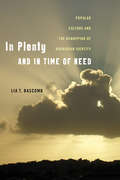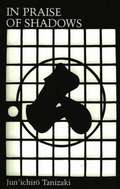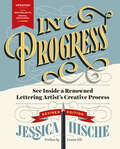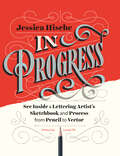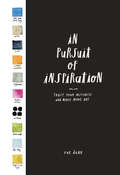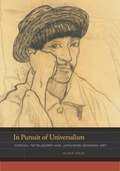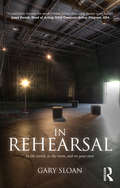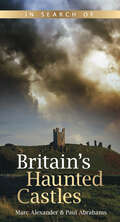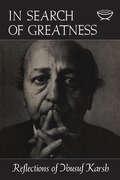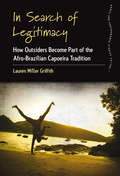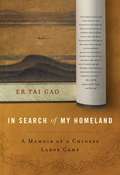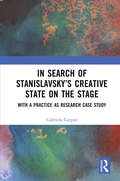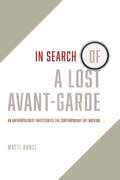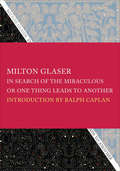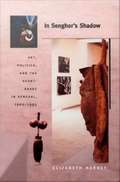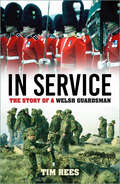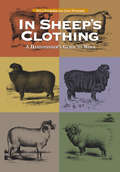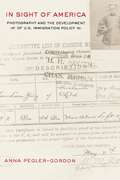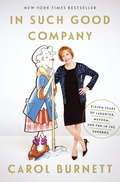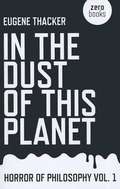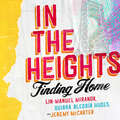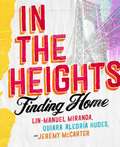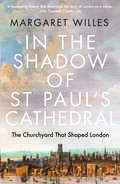- Table View
- List View
In Plenty and in Time of Need: Popular Culture and the Remapping of Barbadian Identity (Critical Caribbean Studies)
by Lia T. BascombIn Plenty and in Time of Need demonstrates how the unique history of Barbados has contributed to complex relations of national, gendered, and sexual identities, and how these identities are represented and interpreted on a global stage. As the most widespread manifestation of social commentary, the book uses music and performance to analyze the competing ideals and realities of the national culture. It details the histories of prominent musical artists, including the prolific Pan-Africanist calypsonian the Mighty Gabby, the world-renowned Merrymen, Soca Queen Alison Hinds, artist/activist Rupee, and international superstar Rihanna. Using these artists, the project analyzes how femininity, masculinity, and sexuality are put in service of Barbadian nationalism. By examining websites, blogs, and digital products of these artists in conversation with Barbadian tourism, the book re-examines the ways in which commodity, sexuality, gender performance, and diasporic consciousness undergird individual careers and national representations.
In Praise Of Shadows
by Edward G. Seidensticker Charles Moore Jun'Ichirō Tanizaki Thomas J. HarperAn essay on aesthetics by the Japanese novelist, this book explores architecture, jade, food, and even toilets, combining an acute sense of the use of space in buildings. The book also includes descriptions of laquerware under candlelight and women in the darkness of the house of pleasure. This was originally written in 1933, between World Wars I and II. The changes in Japan after WWII make this a period piece. This translation has won a major translation award.
In Progress (Revised Edition): See Inside a Renowned Lettering Artist's Creative Process
by Jessica HischeThis revised edition of design-world darling Jessica Hische's career-spanning art book offers a fascinating inside look at her work in progress, featuring highlights from her most exciting recent projects and new tips for lettering with digital tools.In Progress is an inspiring and informative book that showcases the creative prowess and technical expertise behind artist, author, and type designer Jessica Hische's distinctive lettering and typography styles. In explanatory captions throughout these pages, Hische guides readers through the phases of each hand-lettered project—for major clients such as Wes Anderson, NPR, Nike, and more—from gathering inspiration and sketching out rough ideas to revising and refining final designs. With this new edition, readers have the chance to: Revisit the beloved artist’s sketchbook. Follow the evolution of her process over the arc of her career. Learn more about how Hische has integrated digital tools into her practice. Discover more ways to be creative and improve one’s own work. NEW MATERIAL: This revised edition offers up-to-date information about Hische's technical process and go-to tools. Learn more about her approach to drawing digitally on an iPad and delve into inspiring new projects, following them from the first sketch to the final design. DESIGN WORLD LEGEND: Considered a pioneer in the modern lettering movement, Jessica Hische has enjoyed a multi-faceted career with a diverse range of compelling projects—from blockbuster movie titles, book covers, and logo redesigns to original posters and prints. She's spoken at over 100 conferences, colleges, and other design events on nearly every continent, including FITC, Creative Mornings, AIGA, The Brand New Conference, the Build Conference, and more. IN-DEPTH VISUAL RESOURCE: A perfect self-purchase or gift for artists and designers of all levels, from aspiring letterers to professional illustrators looking to hone their skills. With more than 250 full-color images and metallic silver ink used throughout to represent Hische’s penciled sketches, this highly visual book is an essential—and entirely enjoyable—resource for those who practice the art of hand lettering or calligraphy or for anyone who appreciates typography in all its styles and forms. The book also includes a preface by internationally celebrated creative director, graphic designer, type designer, and author Louise Fili.Perfect for: Admirers of Jessica Hische’s lettering work and followers of her popular social media accounts Hand-lettering and calligraphy fans Art and design students, professionals, and enthusiasts Professional designers Bullet journalers, casual creatives, people looking for new artistic hobbies
In Progress: See Inside a Lettering Artist's Sketchbook and Process, from Pencil to Vector
by Jessica HischeThis show-all romp through design-world darling Jessica Hische's sketchbook reveals the creative and technical process behind making award-winning hand lettering. See everything, from Hische's rough sketches to her polished finals for major clients such as Wes Anderson, NPR, and Starbucks. The result is a well of inspiration and brass tacks information for designers who want to sketch distinctive letterforms and hone their skills. With more than 250 images of her penciled sketches, this highly visual ebook is an essential—and entirely enjoyable—resource for those who practice or simply appreciate the art of hand lettering.
In Pursuit of Inspiration: Trust Your Instincts and Make More Art
by Rae DunnIn this visually rich hardcover volume, beloved artist Rae Dunn shares her favorite techniques for approaching a blank page. From drawing with your nondominant hand to sketching with objects found in nature, each chapter offers a simple yet surprising catalyst to help readers get in touch with their own creativity. Full of gorgeous watercolors, sketches, original patterns, dreamy photography, and hand-lettered insight from the author, In Pursuit of Inspiration offers a unique glimpse into the process of a successful fine artist. It's the perfect how-to book for artists of all skill levels who prefer freeform experimentation to step-by-step instruction.
In Pursuit of Universalism: Yorozu Tetsugoro and Japanese Modern Art
by Alicia VolkAlicia Volk constructs a critical theory of artistic modernism in Japan between 1900 and 1930 by analyzing the work of Yorozu Tetsugoro, whose paintings she casts as a polemic response to Japan's late-nineteenth-century encounter with European art.
In Rehearsal: In the World, in the Room, and On Your Own
by Gary SloanIn Rehearsal is a clear and accessible how-to approach to the rehearsal process. Author Gary Sloan brings more than thirty years' worth of acting experience to bear on the question of how to rehearse both as an individual actor and as part of the team of professionals that underpins any successful production. Interviews with acclaimed actors, directors, playwrights, and designers share a wealth of knowledge on dynamic collaboration. The book is divided in to three main stages, helping the reader to refine their craft in as straightforward and accessible manner as possible: In the world: A flexible rehearsal program that can be employed daily, as well as over a typical four week production rehearsal. In the room: Advice on working independently and productively with other members of a company, such as directors, playwrights, designers and technical crew; how your personal creative process varies depending on the role, be it Shakespeare, musicals, film, television or understudying. On your own: Creating your own rehearsal process, exploring original and famous rehearsal techniques, breaking through actor's block and how to practice every day. In Rehearsal breaks down the rehearsal process from the actor’s perspective and equips its reader with the tools to become a generous and resourceful performer both inside and outside the studio. Its independent, creative and daily rehearsal techniques are essential for any modern actor.
In Search of Britain's Haunted Castles
by Paul Abrahams Marc AlexanderBritain’s reputation for its ghostlore remains as intriguing as ever. This book is for those interested in ghostlore – and castles – and for those who wish to visit the scenes of paranormal legend. It could easily be said that in the UK we are spoilt for choice when it comes to atmospheric historic buildings and certainly Britain’s many castles are liberally scattered all over the country. The castles selected in this book have been chosen for their prevalence of spectral tales and the legendary events associated with them: whether grisly executions or bloody battles, their names have become synonymous with their history. This handy pocket history and guide locates and describes over sixty haunted castles and their ghostly inhabitants. Featuring entry information, maps and photographs, and detailed research revealing where supernatural legends associated with castles mirror historical events, this book offers far more than just a collection of spooky tales.
In Search of Greatness: Reflections of Yousuf Karsh
by Yousef KarshIn this book Yousuf Karsh, whose great photographic portraits have revealed so vividly the outstanding personalities of our time, writes about his own life and work. It is the story of an Armenian immigrant boy who rose to be the world's finest portrait photographer, whose pictures, reproduced in newspapers, magazines, and books, and shown in museums, art galleries and exhibitions, have been admired by hundreds of thousands of people all over the world. Of his early years in Armenia, Karsh gives a brief but compelling account, writing without bitterness but not sparing the reader the impact on his youthful mind of the brutalities, massacres, and atrocities of that time. The dramatic impression made on him by his first experiences as a young citizen of Sherbrooke, Quebec. His several years of study in Boston with the famous photographer, Garo, show the gradual development of his ideas and skills in portraiture. In 1932, Karsh opened his own studio in Ottawa, capital city of Canada, and there he met Solange Gauthier, the volatile, charming, and practical Frenchwoman whom he married. Together they established his world-wide reputation. Karsh takes the reader with him to his sittings, and shows how he seeks to bring out the essence of the personalities he is portraying. The reader accompanies Karsh and Madam Karsh as they travel to Washington, New York, Hollywood, across Canada and to the Arctic, and on their European tours, photographing and interviewing statesmen, tycoons, artists, actors, musicians, popes, presidents, and kings. At Karsh's side, the reader hears Churchill's lion roar, the wit of Bernard Shaw, the bark of John L. Lewis, the profound accents of Einstein. He observes the grave serenity of Sibelius, and hears the noble 'cello of Casals. He shares in the problems and disappointments of securing adequate reproduction of the portraits in book form, and in the artist's gratification when Portraits of Greatness, printed by the finest gravure for the University of Toronto Press, appeared in 1959 and the magnificent volume became an immediate best-seller. Yousuf's profession has led him into the high places of the world, and this book is enriched by his twenty years of observation of the celebrities he has encountered. These are the experiences of a distinguished artist, a gifted raconteur, and a delightful human being.
In Search of Legitimacy: How Outsiders Become Part of the Afro-Brazilian Capoeira Tradition (Dance and Performance Studies #7)
by Lauren Miller GriffithEvery year, countless young adults from affluent, Western nations travel to Brazil to train in capoeira, the dance/martial art form that is one of the most visible strands of the Afro-Brazilian cultural tradition. In Search of Legitimacy explores why "first world" men and women leave behind their jobs, families, and friends to pursue a strenuous training regimen in a historically disparaged and marginalized practice. Using the concept of apprenticeship pilgrimage-studying with a local master at a historical point of origin-the author examines how non-Brazilian capoeiristas learn their art and claim legitimacy while navigating the complexities of wealth disparity, racial discrimination, and cultural appropriation.
In Search of My Homeland
by Er Tai GaoThe memoir of Er Tai Gao, a Chinese artist, art critic, and intellectual who spent twenty years in and out of China's gulag until his escape to freedom in Hong Kong in 1992 and his defection to America in 1993 In 1957, twenty-two-year-old art teacher Er Tai Gao came to the attention of the Communist Chinese authorities with his groundbreaking essay "On Beauty," in which he argued that the nature of what is beautiful is both subjective and individual-a position in direct opposition to government policy. Labeled a "rightist" by the Mao regime, Gao was sent to a labor camp in China's harsh western desert, where in just three years 90 percent of his fellow prisoners died. It would be the first of the scholar's three convictions for subversive thought and behavior. After his last imprisonment, in the aftermath of the Tiananmen Square protests, Gao and his wife, Maya, escaped to Hong Kong, and in 1993 were offered political asylum by the United States. Epic in scope, reaching from the depths of work ditches in the Gobi Desert to the heights of the Buddhist heavens depicted on the Dunhuang cave ceilings, In Search of My Homeland is a striking portrayal of Gao's experiences of political persecution, of prisoners pushed to the limits of human endurance, and ultimately of the power of hope. Gao's enormous skill as a writer and insightful observer offers a unique, thoughtful perspective on China in the second half of the twentieth century. Powerful and elegantly written, Gao's work teaches us that freedom is the most important political stand for an artist, to be able to dissent from the dominant ideology--thereby making beauty, both its creation and perception, its ultimate symbol.
In Search of Stanislavsky’s Creative State on the Stage: With a Practice as Research Case Study
by Gabriela CurpanThis book rediscovers a spiritual way of preparing the actor towards experiencing that ineffable artistic creativity defined by Konstantin Stanislavski as the creative state. Filtered through the lens of his unaddressed Christian Orthodox background, as well as his yogic or Hindu interest, the practical work followed the odyssey of the artist, from being oneself towards becoming the character, being structured in three major horizontal stages and developed on another three vertical, interconnected levels. Throughout the book, Gabriela Curpan aims to question both the cartesian approach to acting and the realist-psychological line, generally viewed as the only features of Stanislavski’s work. This book will be of great interest to theatre and performance academics as well as practitioners in the fields of acting and directing.
In Search of Van Gogh: Capturing the Life of the Artist through Photographs and Paintings
by Gloria FossiFollow in the footsteps of Vincent Van Gogh, from his birthplace in Zundert, Netherlands, to his last days in Auvers-sur-Oise, France, and explore the hidden inspirations behind the world-renowned artist’s most famous paintings in this beautiful art book and travelogue, illustrated with more than 250 black-and-white and full-color images throughout.In 1990, two photographers and art enthusiasts, Danilo De Marco and Mario Dondero, set out to explore the details of Vincent Van Gogh’s life, retracing his journey across Europe by foot and by train. Armed with the love and knowledge of Van Gogh’s work, they traveled from the Netherlands to England, Belgium, and France to take in the sights as Van Gogh might have seen them a century earlier. They also turned to art historian Gloria Fossi to better understand, experience, and contextualize Van Gogh’s brilliant mind, drawing insights from his personal letters and other historical documents. Van Gogh’s well-documented travels come alive in this gorgeous book which brings together the landscapes, architecture, portraits, and cultural references that inspired his art. The authors juxtapose vintage and contemporary photographs with Van Gogh’s renditions, demonstrating not only the passage of time, but Van Gogh’s unique artistic vision, brilliantly revealed brushstroke by brushstroke. From the Netherlands, where the artist was born, to his last days in France, no place he visited in his 37 years is left unexplored, and all have become timeless landmarks through his art.In Search of Van Gogh brings into focus the places and objects that inspired and fueled Van Gogh’s artistic genius and offers fresh insights into his prolific work and process. In searching for the artist’s mind and soul, the authors create a pointillistic portrait of a human being whose life was remarkable, and whose story must be shared for generations to come.
In Search of a Lost Avant-Garde: An Anthropologist Investigates the Contemporary Art Museum
by Matti BunzlIn 2008, anthropologist Matti Bunzl was given rare access to observe the curatorial department of Chicago’s Museum of Contemporary Art. For five months, he sat with the institution’s staff, witnessing firsthand what truly goes on behind the scenes at a contemporary art museum. From fund-raising and owner loans to museum-artist relations to the immense effort involved in safely shipping sixty works from twenty-seven lenders in fourteen cities and five countries, Matti Bunzl’s In Search of a Lost Avant-Garde illustrates the inner workings of one of Chicago’s premier cultural institutions. Bunzl’s ethnography is designed to show how a commitment to the avant-garde can come into conflict with an imperative for growth, leading to the abandonment of the new and difficult in favor of the entertaining and profitable. Jeff Koons, whose massive retrospective debuted during Bunzl's research, occupies a central place in his book and exposes the anxieties caused by such seemingly pornographic work as the infamous Made in Heaven series. Featuring cameos by other leading artists, including Liam Gillick, Jenny Holzer, Karen Kilimnik, and Tino Sehgal, the drama Bunzl narrates is palpable and entertaining and sheds an altogether new light on the contemporary art boom.
In Search of the Miraculous: Or, One Thing Leads to Another
by Milton GlaserThe iconic graphic designer presents &“a self-analysis of his creative process . . . [in] arguably his proudest accomplishment&” (The Atlantic). Milton Glaser is perhaps the most celebrated graphic designer in the world. As a young man, he read a phrase that stayed with him through his life: &“In Search of the Miraculous.&” One could say that all human experience is a miracle—memory, color, taste, Vermeer, stars, watermelon, etc. For those like Glaser, the act of making things that move the mind is perhaps the deepest aspiration to the miraculous. In this volume, he has chosen work, largely created by him over the last five years, to demonstrate how one concept leads to another. Through fascinating juxtapositions, readers will gain insights into Glaser&’s oeuvre, journeying with him as he discovers that seemingly new designs frequently come out of provocative ideas taken from the distant past. &“Elegant . . . The text and the picture positively embrace and dance together.&” —The New York Times &“To younger graphic designers, Glaser has the stature of Marlon Brando in Hollywood . . . He appears to have thought more deeply about what he makes than many lionized by the contemporary art world and its market.&” —San Francisco Chronicle &“In Search of the Miraculous aptly captures the tension involved in reconciling the artist&’s aspirations to do great work and the client&’s objectives. This book eloquently, articulately, and with great panache, and provocation, illuminates the extraordinary outcomes that emerge when the artistic process miraculously works.&” —New York Journal of Books
In Senghor's Shadow: Art, Politics, and the Avant-Garde in Senegal, 1960-1995
by Elizabeth HarneyIn Senghor's Shadow is a unique study of modern art in postindependence Senegal. Elizabeth Harney examines the art that flourished during the administration of Lopold Sdar Senghor, Senegal's first president, and in the decades since he stepped down in 1980. As a major philosopher and poet of Negritude, Senghor envisioned an active and revolutionary role for modern artists, and he created a well-funded system for nurturing their work. In questioning the canon of art produced under his aegis--known as the Ecole de Dakar--Harney reconsiders Senghor's Negritude philosophy, his desire to express Senegal's postcolonial national identity through art, and the system of art schools and exhibits he developed. She expands scholarship on global modernisms by highlighting the distinctive cultural history that shaped Senegalese modernism and the complex and often contradictory choices made by its early artists. Heavily illustrated with nearly one hundred images, including some in color, In Senghor's Shadow surveys the work of a range of Senegalese artists, including painters, muralists, sculptors, and performance-based groups--from those who worked at the height of Senghor's patronage system to those who graduated from art school in the early 1990s. Harney reveals how, in the 1970s, avant-gardists contested Negritude beliefs by breaking out of established artistic forms. During the 1980s and 1990s, artists such as Moustapha Dim, Germaine Anta Gaye, and Kan-Si engaged with avant-garde methods and local artistic forms to challenge both Senghor's legacy and the broader art world's understandings of cultural syncretism. Ultimately, Harney's work illuminates the production and reception of modern Senegalese art within the global arena.
In Service: The Story of a Welsh Guardsman
by Tim ReesIn Service is the tale of one person's journey into manhood, ultimately finding himself in the theatre of war. It is a journey littered with colourful anecdotes and diverse experience: from military training in the Guards Depot to Trooping the Colour; from academic failure to intelligence work in Northern Ireland; from helping Rudolf Hess out of an ambulance to being tasked with taking the Queen's portrait. Tim Rees colours every experience with profound and often idiosyncratic observations that offer the reader a taste of the sometimes humorous, often arduous and, on too many occasions, brutal reality of service. But, as Tim says, 'The positive effect is the bond of common experience I share with men with whom I served in the army' - a type of bond that, in his opinion, is in danger of being lost in the modern age.
In Sheep's Clothing; Paperbound: A Handspinner's Guide To Wool
by Nola Fournier Elisabeth FournierThis highly readable, authoritative reference provides a comprehensive look at the characteristics of wool of 100 breeds of sheep. Essential reading for handspinners, wool growers, and other fiber craft enthusiasts.
In Sight of America: Photography and the Development of U. S. Immigration Policy
by Anna Pegler-GordonThis work is the first to take a comprehensive look at the history of immigration policy in the United States through the prism of visual culture. Anna Pegler-Gordon considers the role and uses of visual documentation at Angel Island for Chinese immigrants, at Ellis Island for European immigrants, and on the U.S.-Mexico border.
In Sight of America: Photography and the Development of U.S. Immigration Policy (American Crossroads #28)
by Dr. Anna Pegler-GordonWhen restrictive immigration laws were introduced in the late-nineteenth and early-twentieth centuries, they involved new requirements for photographing and documenting immigrants--regulations for visually inspecting race and health. This work is the first to take a comprehensive look at the history of immigration policy in the United States through the prism of visual culture. Including many previously unpublished images, and taking a new look at Lewis Hine's photographs, Anna Pegler-Gordon considers the role and uses of visual documentation at Angel Island for Chinese immigrants, at Ellis Island for European immigrants, and on the U.S.-Mexico border. Including fascinating close visual analysis and detailed histories of immigrants in addition to the perspectives of officials, this richly illustrated book traces how visual regulations became central in the early development of U.S. immigration policy and in the introduction of racial immigration restrictions. In so doing, it provides the historical context for understanding more recent developments in immigration policy and, at the same time, sheds new light on the cultural history of American photography.
In Such Good Company: Eleven Years of Laughter, Mayhem, and Fun in the Sandbox
by Carol Burnett<P>Comedy legend Carol Burnett tells the hilarious behind-the-scenes story of her iconic weekly variety series, The Carol Burnett Show. <P>Who but Carol Burnett herself has the timing, talent, and wit to pull back the curtain on the Emmy-Award winning show that made television history for eleven glorious seasons? In Such Good Company delves into little-known stories of the guests, sketches and antics that made the show legendary, as well as some favorite tales too good not to relive again. Carol lays it all out for us, from the show's original conception to its evolution into one of the most beloved primetime programs of its generation. <P>Written with all the charm and humor fans expect from a masterful entertainer like Carol Burnett, In Such Good Company skillfully highlights the elements that made the show so successful in a competitive period when TV variety shows ruled the air waves. Putting the spotlight on everyone from her talented costars to her amazing guest stars--the most celebrated and popular entertainers of their day--Carol crafts a lively portrait of the talent and creativity that went into every episode. <P>Here are all the topics readers want to know more about, including: * how the show almost didn't air due to the misgivings of certain CBS vice presidents; * how she discovered and hired Harvey Korman, Vicki Lawrence, Lyle Waggoner, and Tim Conway; * anecdotes about guest stars and her close freindships with many of them, including Lucille Ball, Roddy Mcdowell, Jim Nabors, Bernadette Peters, Betty Grable, Steve Lawrence, Eydie Gorme, Gloria Swanson, Rita Hayworth, and Betty White; * the people behind the scenes from Bob Mackie, her costume designer and partner in crime, to the wickedly funny cameraman who became a fixture during the show's opening Q&A; * and Carol's takes on her favorite sketches and the unpredictable moments that took both the cast and viewers by surprise. <P>This book is Carol's love letter to a golden era in television history through the lens of her brilliant show which won no less than 25 Emmy Awards! Get the best seat in the house as she reminisces about the outrageous tales that made working on the show as much fun as watching it. <P><b>A New York Times Bestseller</b>
In The Dust of This Planet (Horror of Philosophy, volume #1)
by Eugene ThackerThe world is increasingly unthinkable, a world of planetary disasters, emerging pandemics, and the looming threat of extinction. In this book Eugene Thacker suggests that we look to the genre of horror as offering a way of thinking about the unthinkable world. To confront this idea is to confront the limit of our ability to understand the world in which we live - a central motif of the horror genre. In the Dust of This Planet explores these relationships between philosophy and horror. In Thacker's hands, philosophy is not academic logic-chopping; instead, it is the thought of the limit of all thought, especially as it dovetails into occultism, demonology, and mysticism. Likewise, Thacker takes horror to mean something beyond the focus on gore and scare tactics, but as the under-appreciated genre of supernatural horror in fiction, film, comics, and music.
In The Heights: Finding Home **The must-have gift for all Lin-Manuel Miranda fans**
by Lin-Manuel Miranda Jeremy McCarter Quiara Alegria HudesThe eagerly awaited follow-up to the #1 New York Times bestseller Hamilton: The Revolution, Lin-Manuel Miranda's new book gives readers an extraordinary inside look at In the Heights, his breakout Broadway debut, written with Quiara Alegría Hudes, soon to be a Hollywood blockbuster.In 2008, In the Heights, a new musical from up-and-coming young artists, electrified Broadway. The show's vibrant mix of Latin music and hip-hop captured life in Washington Heights, the Latino neighborhood in upper Manhattan. It won four Tony Awards and became an international hit, delighting audiences around the world. For the film version, director Jon M. Chu (Crazy Rich Asians) brought the story home, filming its spectacular dance numbers on location in Washington Heights. That's where Usnavi, Nina, and their neighbors chase their dreams and ask a universal question: Where do I belong?In the Heights: Finding Home reunites Miranda with Jeremy McCarter, co-author of Hamilton: The Revolution, and Quiara Alegría Hudes, the Pulitzer Prize-winning librettist of the Broadway musical and screenwriter of the film. They do more than trace the making of an unlikely Broadway smash and a major motion picture: They give readers an intimate look at the decades-long creative life of In the Heights.Like Hamilton: The Revolution, the book offers untold stories, perceptive essays, and the lyrics to Miranda's songs-complete with his funny, heartfelt annotations. It also features newly commissioned portraits and never-before-seen photos from backstage, the movie set, and productions around the world.This is the story of characters who search for a home-and the artists who created one.(P)2021 Penguin Audio
In The Heights: Finding Home **The origin story behind the feelgood film of the summer**
by Lin-Manuel Miranda Jeremy McCarter Quiara Alegria HudesLin-Manuel Miranda's new book gives readers an extraordinary inside look at In the Heights, his breakout Broadway debut, written with Quiara Alegría Hudes, now a Hollywood blockbuster.WHAT FANS ARE SAYING... "This book is so beautiful I want to cry." ~ "I genuinely think I've needed this for years." ~ "Reading this book made my love for both the musical and movie versions of In the Heights grow even more."In 2008, In the Heights, a new musical from up-and-coming young artists, electrified Broadway. The show's vibrant mix of Latin music and hip-hop captured life in Washington Heights, the Latino neighborhood in upper Manhattan. It won four Tony Awards and became an international hit, delighting audiences around the world. For the film version, director Jon M. Chu (Crazy Rich Asians) brought the story home, filming its spectacular dance numbers on location in Washington Heights. That's where Usnavi, Nina, and their neighbors chase their dreams and ask a universal question: Where do I belong?In the Heights: Finding Home reunites Miranda with Jeremy McCarter, co-author of Hamilton: The Revolution, and Quiara Alegría Hudes, the Pulitzer Prize-winning librettist of the Broadway musical and screenwriter of the film. They do more than trace the making of an unlikely Broadway smash and a major motion picture: They give readers an intimate look at the decades-long creative life of In the Heights.Like Hamilton: The Revolution, the book offers untold stories, perceptive essays, and the lyrics to Miranda's songs-complete with his funny, heartfelt annotations. It also features newly commissioned portraits and never-before-seen photos from backstage, the movie set, and productions around the world.This is the story of characters who search for a home-and the artists who created one.
In The Shadow of St. Paul's Cathedral: The Churchyard that Shaped London
by Margaret WillesThe extraordinary story of St. Paul’s Churchyard—the area of London that was a center of social and intellectual life for more than a millennium St. Paul’s Cathedral stands at the heart of London, an enduring symbol of the city. Less well known is the neighborhood at its base that hummed with life for over a thousand years, becoming a theater for debate and protest, knowledge and gossip. For the first time Margaret Willes tells the full story of the area. She explores the dramatic religious debates at Paul’s Cross, the bookshops where Shakespeare came in search of inspiration, and the theater where boy actors performed plays by leading dramatists. After the Great Fire of 1666, the Churchyard became the center of the English literary world, its bookshops nestling among establishments offering luxury goods. This remarkable community came to an abrupt end with the Blitz. First the soaring spire of Old St. Paul’s and then Wren’s splendid Baroque dome had dominated the area, but now the vibrant secular society that had lived in their shadow was no more.
